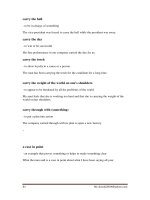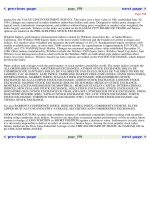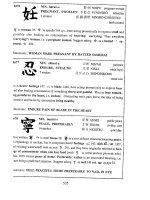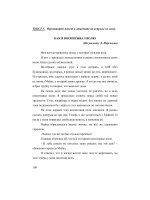Medical English phần 9 ppsx
Bạn đang xem bản rút gọn của tài liệu. Xem và tải ngay bản đầy đủ của tài liệu tại đây (225.11 KB, 19 trang )
PLS Primary lateral sclerosis
PROMM Proximal myotonic myopathy
PTSD Posttraumatic stress disorder
PVS Persistent vegetative state
REM Rapid eye movements
SAH Subarachnoid hemorrhage
SCA Spinocerebellar ataxia
SCCD Subacute cortical cerebellar degeneration
SEP Somatosensory evoked potential
SER Somatosensory evoked response
SSPE Subacute sclerosing panencephalitis
SSRI Selective serotonin reuptake inhibitor
TCA Tricyclic antidepressant
TIA Transient ischemic attack
TMB Transient monocular blindness
VEP Visual evoked potential
Obstetrics and Gynecology
AFP a-Fetoprotein
AID Artificial insemination donor
AIH Artificial insemination (homologous)
CIN Cervical intraepithelial neoplasia
CHL Crown-heel length
CRL Crown-rump length
DES Diethylstilbestrol
GIFT Gamete intrafallopian transfer
HCG Human chorionic gonadotropin
HRT Hormone replacement therapy
IUCD, IUD Intrauterine contraceptive device
IUI Intrauterine insemination
LFT Left frontotransverse position
LMA Left mentoanterior position
LMP Left mentoposterior position
LMT Left mentotransverse position
LOT Left occipitotransverse position
LSA Left sacroanterior position
LSP Left sacroposterior position
LST Left sacrotransverse position
MP Mentoposterior position
MPC Mucopurulent cervicitis
OA Occipitoanterior position
OB/GYN Obstetrics and gynecology
PID Pelvic inflammatory disease
PMS Premenstrual syndrome
RFP Right frontoposterior position
Abbreviation Lists
159
RFT Right frontotransverse position
RMA Right mentoanterior position
RMP Right mentoposterior position
RMT Right mentotransverse position
ROA Right occipitoanterior position
ROP Right occipitoposterior position
ROT Right occipitotransverse position
RPO Right posterior oblique (a radiographic position)
RSA Right sacroanterior position
RSP Right sacroposterior position
RST Right sacrotransverse position
SP Sacroposterior position
VACTERL Abnormalities of vertebrae, anus, cardiovascular tree,
syndrome trachea, esophagus, renal system, and limb buds (asso-
ciated with administration of sex steroids during early
pregnancy)
Oncology
AGCUS Atypical glandular cells of undetermined significance
ASCUS Atypical squamous cells of undetermined significance
CEA Carcinoembryonic antigen
CIS Carcinoma in situ
CMV Cisplatin, methotrexate, and vinblastine (a cancer drug
combination treatment)
CUPS Cancer of unknown primary site
HGSIL High-grade squamous intraepithelial lesion
LGSIL Low-grade squamous intraepithelial lesion
MFH Malignant fibrous hystiocytoma
PNET Primitive neuroectodermal tumors
TAF Tumor angiogenic factor
TNM staging Tumor-node-metastasis
Ophthalmology
AC/A Accommodative convergence ± accommodation ratio
ARN Acute retinal necrosis
DCG Dacryocystography
DUSN Diffuse unilateral subacute neuroretinitis
EOG Electrooculography
ERG Electroretinogram
LE Left eye
PORN Progressive outer retinal necrosis
RE Right eye
TRIC Trachoma and inclusion conjunctivitis
Unit VII Acronyms and Abbreviations
160
Orthopedics
ABC Aneurysmal bone cyst
A-E Above-the-elbow (amputation)
A-K Above-the-knee (amputation)
ALPSA Anterior labroligamentous periosteal sleeve avulsion
B-E Below-the-elbow (amputation)
BHAGL Bony humeral avulsion of glenohumeral ligament
B-K Below-the-knee (amputation)
CPPD Calcium pyrophosphate dihydrate deposition
CTD Cumulative trauma disorders
DISH Diffuse idiopathic skeletal hyperostosis
DISI Dorsal intercalated segmental instability
EDM Multiple epiphyseal dysplasia
GLAD Glenolabral articular disruption
HAGL Humeral avulsion of glenohumeral ligament
HNP Herniated nucleus pulposus
HOA Hypertrophic osteoarthropathy
ITOH Idiopathic transient osteoporosis of the hip
MAST Military antishock trousers
OCD Osteochondritis dissecans
OI Osteogenesis imperfecta
OSMED Otospondylomegaepiphyseal dysplasia
PVNS Pigmented villonodular synovitis
RSD Reflex sympathetic dystrophy
SAPHO Synovitis, acne, pustulosis, hyperostosis, and osteitis
syndrome
SCFE Slipped capital femoral epiphysis
SEDC Spondyloepiphyseal dysplasia congenita
SLAC Scapholunate advanced collapse
SLAP Superior labrum, anterior-posterior
(lesion of the glenoid labrum)
TMJ Temporomandibular joint
TOS Thoracic outlet syndrome
Otorhinolaryngology
ABG Air-bone gap in otoscopy (conductive hearing loss)
ABR Auditory brainstem response
ART Acoustic reflex threshold
BSER Brainstem evoked response
CIC Completely in the canal hearing aid
ENT Ears, nose, and throat
NUG Necrotizing ulcerative gingivitis
OAE Otoacoustic emission
Abbreviation Lists
161
SISI Small increment sensitivity index
(test for cochlear damage)
Pediatrics
BIDS Brittle hair, impaired intelligence, decreased fertility,
and short stature
CDH Congenital dislocation of the hip
DDH Developmental dysplasia of hip
LEOPARD Lentigines, electrocardiographic abnormalities, ocular
syndrome hypertelorism, pulmonary stenosis, abnormalities of
genitalia, retardation of growth, and deafness
SBS Shaken baby syndrome
SIDS Sudden infant death syndrome
Pharmacology
ACEI Angiotensin-converting enzyme inhibitor
AZT Azidothymidine
CDCA Chenodeoxycholic acid
DMARD Disease-modifying antirheumatic drugs
MAOI Monoamine oxidase inhibitors
MPD Maximum permissible dose
MRD, mrd Minimal reacting dose
MS Morphine sulfate
NSAID Nonsteroidal anti-inflammatory drug
SSRI Selective serotonin reuptake inhibitor
Pneumology
A-aO
2
Alveolar-arterial oxygen partial pressure difference
difference
ABG Air-bone gap
ABG Arterial blood gas
ABPA Allergic bronchopulmonary aspergillosis
ACMV Assist control mode ventilation
ALI Acute lung injury
ARDS Adult respiratory distress syndrome
ARF Acute respiratory failure
Auto-PEEP Auto-positive end-expiratory pressure
BAL Bronchoalveolar lavage
BALT Bronchus-associated lymphoid tissue
BiPAP Bilevel positive airway pressure
BOOP Bronchiolitis obliterans with organizing pneumonia
BPF Bronchopleural fistula
BVM Bag-valve-mask device
Unit VII Acronyms and Abbreviations
162
CF Cystic fibrosis
CFTR Cystic fibrosis transmembrane regulator
CO Cardiac output
COPD Chronic obstructive pulmonary disease
CPAP Continuous positive airway pressure
CPPB Continuous positive pressure breathing
CSA Central sleep apnea
CWP Coal workers' pneumoconiosis
DIC Disseminated intravascular coagulation
DL
CO
Diffusing capacity of the lung for carbon monoxide
2,3-DPG 2,3-Diphosphoglycerate
DVT Deep venous thrombosis
ECHO Extracorporeal membrane oxygenation
ERV Expiratory reserve volume
FEF Forced expiratory flow
FEFn±n% Forced expiratory flow between n% and n% of the vital
capacity
FET Forced expiratory time
FEV 1 Forced expiratory volume in 1 second
FIO
2
Fractional concentration of inspired O
2
FRC Functional residual capacity
FVC Forced vital capacity
HFV High-frequency ventilation
HP Hypersensitivity pneumonitis
HRCT High-resolution CT
IC Inspiratory capacity
ILD Interstitial lung disease
IMV Intermittent mandatory ventilation
IPC Intermittent pneumatic compression
IPF Idiopathic pulmonary fibrosis
IPPV Intermittent positive pressure ventilation
IRV Inspiratory reserve volume
MBC Maximum breathing capacity
MEP Maximum expiratory pressure
MIP Maximum inspiratory pressure
MMFR Maximal midexpiratory flow rate
MOF Multiple organ failure
NEEP Negative end-expiratory pressure
NO Nitric oxide
ODTS Organic dust toxic syndrome
OSA Obstructive sleep apnea
PAH Primary alveolar hypoventilation
PAP Pulmonary alveolar proteinosis
PAP Pulmonary arterial pressure
PAV Proportional assist ventilation
PCV Pulmonary vascular resistance
Abbreviation Lists
163
PCWP Pulmonary capillary wedge pressure
PEEP Positive end-expiratory pressure
PEFR Peak flowmeter
PEFR Peak expiratory flow rate
PF Pleural fluid
PFT Pulmonary function test
PIOPED Prospective investigation of pulmonary embolism
diagnosis
PMF Progressive massive fibrosis
PNPB Positive-negative pressure breathing
PPV Positive pressure ventilation
PSB Protected double-sheathed brush
PSV Pressure-support ventilation
PTE Pulmonary thromboembolism
Ptp Transpulmonary pressure
PVR Pulmonary vascular resistance
RQ Respiratory quotient
RV Residual volume
SIMV Synchronized intermittent mandatory ventilation
TBB Transbronchial biopsy
TLC Total lung capacity
TTA Transtracheal aspiration
VA Alveolar ventilation
VATS Video-assisted thoracic surgery
VC Vital capacity
Vt Tidal volume
VTE Venous thromboembolism
Psychiatry
ADD Attention deficit disorder
ADHD Attention deficit hyperactivity disorder
CA Chronological age
DSM-IV Diagnostic and statistical manual (an American
Psychiatric Association publication that classifies mental
illnesses)
DT Delirium tremens
ECT Electroconvulsive therapy
IQ Intelligence quotient
MA Mental age
OCD Obsessive compulsive disorder
SAD Seasonal affective disorder
STM Short-term memory
Unit VII Acronyms and Abbreviations
164
Radiology
DTPA Diethylene triamine pentaacetic acid (a binding
substance for both Gd and 99m-Tc)
ALARA As low as reasonably achievable (radiation dosages)
AMBER Advanced multiple-beam equalization radiography
BE Barium enema
CT Computed tomography
DICOM Digital Imaging and Communications in Medicine
(a joint standard of the American College of Radiology
and National Equipment Manufacturers' Association)
DSA Digital subtraction angiography
EBT Electron beam tomography
FSE Fast spin echo (a magnetic resonance sequence)
Fr French scale (catheters)
GRASS Gradient-recalled acquisition in the steady state
(a magnetic resonance sequence)
GRE Gradient echo imaging (a magnetic resonance sequence)
HRCT High-resolution computed tomography
IVU Intravenous urogram
LAO Left anterior oblique position
LPO Left posterior oblique position
MIP Maximum intensity projection
MRI Magnetic resonance imaging
PACS Picture archive and communication system (a computer
network for digitized radiological images and reports)
PET Positron emission tomography
PTA Percutaneous transluminal angioplasty
PTHC, PTC Percutaneous transhepatic cholangiography
RAO Right anterior oblique
SE Spin echo (a magnetic resonance sequence)
SNR Signal-to-noise ratio
SPECT Single photon emission computed tomography
STIR Short tau inversion recovery imaging
(a magnetic resonance sequence)
TE Echo time (in magnetic resonance spin echo pulse
sequences)
TIPS Transjugular intrahepatic portosystemic shunt
TR Repetition time
UGI Upper gastrointestinal series
VCUG Voiding cystourethrogram
XR X-ray
Abbreviation Lists
165
Urology
BPH Benign prostatic hyperplasia
ESWL Extracorporeal shock wave lithotripsy
GU Genitourinary
PIN Prostatic intraepithelial neoplasia
PSA Prostate-specific antigen
SUI Stress urinary incontinence
Unit VII Acronyms and Abbreviations
166
UNIT VIII
Communication Skills
Good communication between doctor and patient is vital in order to estab-
lish an accurate medical history. In the following pages we show several
key sentences which can help you when interviewing a patient.
1. Greeting and introducing oneself:
± Good morning, Mr. Lee. Come and sit down. I'm Dr. Vida.
± Good afternoon, Mrs. Lafontaine. Take a seat, please.
2. Invitation to describe symptoms:
± Well now, what seems to be the problem?
± Well, how can I help you?
± Would you please tell me how I can help you?
± Your GP (general practitioner) says you've been having trouble with
your right shoulder. Tell me about it.
± My colleague Dr. Sanders says your left knee has been aching lately.
Is that correct?
3. Instructions for undressing:
± Would you mind taking off all your clothes except your underwear?
(men).
± Would you please take off all your clothes except your underwear and
bra? (women).
± You should take off your underwear too.
± Lie on the couch and cover yourself with the blanket.
± Lie on the stretcher with your shoes and socks off, please.
± Roll your sleeve up, please, I'm going to examine your elbow.
4. Instructions for position on couch:
± Lie down, please (supine position).
± Lie on your tummy, please (prone position).
± Please turn over and lie on your back again.
± Roll over onto your right side.
± Sit up and bend you knees.
± Lean forward.
± Get off the stretcher.
Unit VIII The Clinical History
± Stand up, please.
± Lie on your back with your knees bent and your legs wide apart.
± Lie on your tummy and relax.
± Let yourself go loose.
5. Instructions to get dressed:
± You can get dressed now. Take your time, we are not in a hurry.
± Please get dressed. Take your time, we are not in a hurry.
6. No treatment:
± There is nothing wrong with you.
± This will clear up on its own.
± There doesn't seem to be anything wrong with your shoulder.
The Chart
A typical completed clinical history chart is shown in Table 1. As you can
see, in case you were not aware of it, a chart is almost entirely written in
doctors' shorthand. Get a chart, photocopy it and go over it thoroughly;
the sooner you do it the better.
Taking a Clinical History
Since we take for granted that your English level allows you to understand
most of the possible questions to ask patients and being aware that every
specialty has questions of its own, this section does not intend to be an or-
dinary guide. Its only intention is to serve as an example and it is aimed
at encouraging you to create your own list of questions and comments.
In Table 2 we provide a list of common phrases that patients use to de-
scribe their symptoms and the meaning of these phrases.
Questions and Commands
1. To begin the interview:
± Well now, how can I help you?
± What's brought you along today?
± What can I do for you?
± What seems to be the problem?
± Well Mr. Goyen, what's the trouble?
± Your doctor says you've been having trouble with your knees.
Tell me about it.
± How long has/have it/they been bothering you?
Unit VIII The Clinical History
170
Taking a Clinical History
171
Table 1. Typical clinical history chart
Surname (1st): Hall Surname (2nd): First name(s): Kevin
Age: 32 Sex: M Marital status: M
Occupation: Truck driver
Present complaint: Frontal headaches 3/12
a
. Worse in a.m. ªDullº
b
, ªthrobbingº
c
.
Relieved by lying down.
Also c/o
d
progressive deafness.
O/E
e
:
General condition: Obese, 1.65 m tall, 85 kg weight
ENT
f
:Wax
g
++, both sides
RS
h
: NAD
i
CVS
j
:P
k
80/min reg
l
,BP
m
180/120, HS
n
Normal
GIS
o
:
GUS
p
:
CNS
q
: Fundi
r
normal
Immediate past history: Weight gain
Points of note: None
Investigations
s
:
Urine -ve
t
for sugar and albumin
Retinoscopy
Diagnosis: Hypertension
Management:
Date: 26/03/99 Signature: Peter Weiss MD.
a
3/12 For 3 months (similarly, 6/52 6 weeks and 4/7 4 days).
b
Dull ªA dull sort of acheº. Not felt distinctly. Not sharp.
c
Throbbing Beating more rapidly than usual.
d
c/o Complains of.
e
O/E On examination.
f
ENT Ear±nose±throat.
g
Wax Wax within the external auditory canal.
h
RS Respiratory system.
i
NAD Nothing abnormal detected, also Non-apparent distress.
j
CVS Cardiovascular system.
k
P Pulse.
l
reg Regular (other: SR Sinus rhythm).
m
BP Blood pressure.
n
HS Heart sounds.
o
GIS Gastrointestial system.
± How long have you had it/them?
± How long have you been ill?
± Did it start all of a sudden?
± How many days have you been indisposed?
± What do you think the reason is?
± Do you think there is any explanation?
2. General questions/commands:
± How many times?
± How much?
± How often?
± How old are you?
± Have you had bleeding?
± Have you had fever?
± Have you had any nose bleeding?
± Have you lost weight lately?
± Open your mouth, please.
± Please remove your clothing.
± Raise your arm.
± Raise it more.
± Say it once again.
± Stick out your tongue.
± Swallow please.
± Take a deep breath.
± Breathe normally.
± Grasp my hand.
± Try again.
± Bear down as if you were to have a bowel movement
(Valsalva's maneuver).
± Please lie on your tummy (prone position).
± Please turn over and lie on your back.
± Roll over onto your right/left side.
± Bend your knees.
± Keep your right knee bent.
± Lean forward.
± Get off the couch and stand up.
± Walk across the room.
± You can get dressed now. Don't hurry. Take your time.
Unit VIII The Clinical History
172
continued fotenote to Table 1
p
GUS Genitourinary system.
q
CNS Central nervous system.
r
Fundi Equivalent to ªfoundº.
s
Investigations Tests.
t
±ve negative (+ve positive).
Taking a Clinical History
173
Table 2. Common phrases used by patients, and their meaning
When a patient says. . . The doctor understands . . .
I can't breath or I'm stuffed up or my chest is tight Dyspnea
Everything is spinning Vertigo
It itches me Pruritus
It stings when I pee Dysuria
I can't eat or I've lost my appetite Anorexia
I don't feel like doing anything Asthenia
Headache Cephalgia
My nose is dripping Rhinorrhea
I've vaginal dripping Leukorrhea
I'm having my period Menstruation
My hair is falling out Alopecia
I can't remember a thing Amnesia
My skin looks yellow Jaundice
I can't move (a limb) Paralysis
I can't see anything Blindness
Bad breath Halitosis
I've a cavity Caries
It hurts when I swallow Odynophagia
I can't swallow Dysphagia
I spit out phlegm (when I cough) Sputum
Cough up blood Hemoptysis
My stomach is burning Epigastralgia
I wheeze Wheeze
I've a prickly sensation Paresthesia
I've a burning sensation Pyrosis
I feel like I'm going to throw up Nausea
I'm always running to the bathroom Polyuria
I always feel like I have to pee Tenesmus
I'm always thirsty or I'm always dry Polydipsia
I've a rash Erythema
My . is swollen Edema
My skin looks blue Cyanosis
My chest feels constricted Thoracic pain
My mouth is always watering Sialorrhea
I can't breath when I lie down Orthopnea
My stool is black Melena
My stool is white Acholia
My urine is dark Choluria
I can't sleep Insomnia
I can't go to the bathroom Anuria
Bruise Hematoma
Toothache Odontalgia
Common Symptom Areas
Pain
· Questions:
± Which part of your (head, arm, face, chest, .) is affected?
± Where does it hurt?
± Where is it sore?
± Can you describe the pain?
± What is the pain like?
± Is your pain severe?
± What kind of pain is yours?
± Is there anything that makes it better?
± Does anything make it worse?
± Does anything relieve the pain?
± What effect does food have?
± Does lying down help the pain?
· Describing the characteristics of pain:
± A dull sort of pain.
± A feeling of pressure.
± Very sore, like a knife.
± A burning pain.
± A gnawing kind of pain.
± A sharp, stabbing pain.
±Raw.
± The pain's gone.
± A sharp pain.
± I ache all over.
± I'm in a lot of pain.
± I've got a very sore arm.
Fever
· I think I have a temperature.
· I think I'm running a fever.
· High fever.
· High temperature.
· When do you have the highest temperature?
· Do you shiver?
· Were you cold last night?
· When does your temperature come down?
Unit VIII The Clinical History
174
Sickness
· I feel queasy.
· I feel sick.
· I think I'm going to vomit.
· I think I'm going to throw everything up.
· I think I'm going to bring up.
· My head is swimming.
· I feel dizzy.
· He's feeling giddy.
· She's feeling faint.
Weakness
· I feel weak.
· I'm tired.
· I'm not in the mood for .
· Are you hungry?
· I've lost weight.
· Do you still feel very weak?
Sleep
· Do you feel sleepy?
· Do you sleep deeply?
· I wake up too early.
· Do you snore?
Vision
· I can't see properly.
· Everything is fuzzy.
· I can't see with my left/right eye.
· My eye is itchy.
· My eye is stinging/burning.
· What have you done to your eye?
· What's happened to your eye?
Others
· Have you had a cough?
· Do you pass any blood?
· Do you have a discharge?
· My foot has gone to sleep.
· The patient went into a coma.
Taking a Clinical History
175
Key Words About Symptoms and Signs
General Symptoms
· Malaise
· Anorexia (no appetite)
· Weakness
· Vomiting (throw up)
· Myalgia
· Muscle pain
· Sweats
· Weight loss
· Weight gain
· Drowsiness
· Night sweats
· Insomnia
· Chills
· Numbness
· Tingling
· Fever
· Constipation
· Regular movements
· Diarrhea
Skin
· Rash
· Lump
· Pruritus
· Itch
· Scar
· Bruising
· Spots
· Blackhead
· Moles
· Swelling
· Puffiness
· Tingle
Respiratory System
· Cough
· Productive cough
· Unproductive cough
· Hemoptysis
Unit VIII The Clinical History
176
· Cough up blood
· Cough up phlegm or spit
· Coryza
· Runny nose
· Sputum
· Sore throat
· Pleuritic pain
· Dyspnea
· Breathlessness
· Out of puff
· Chest pain
· Orthopnea
· Breathless on lying down
Cardiovascular System
· Chest pain
· Pain behind the breast bone
· Intermittent claudication
· Cramps
· Palpitations
· Angina
· Tachycardia
· Cyanosis
Gastrointestinal System
· Abdominal pain
· Nausea
· Vomitus
· Vomit
· Diarrhea
· Constipation
· Flatulence
· A coated tongue
Genitourinary System
· Polyuria
· Dysuria
· Pollakiuria
· Tenesmus
· Leukorrhea
· Menorrhagia
· Dysmenorrhea
· Impotence
Taking a Clinical History
177
· Frigidity
· Menstrual cramps
Nervous System
· Tremor
· Rigidity
· Seizure
· Paralysis
· Palsy
· Paresthesia
· Reflex
· Ataxia
· Incontinence
· Jumbled speech
· Knee jerk
Patient Examination
Initial Examination
Level of Consciousness
· Altered level of consciousness
· GCS (Glasgow coma scale)
· Loss of consciousness
· Alert and oriented
Circulation
· Heart tones/sounds
· Clear
· Distant
· Regular/Irregular
· Muffled
· Pulse
Breathing
· Rhythm
· Depth
± Adequate
± Shallow
± Deep
Unit VIII The Clinical History
178









